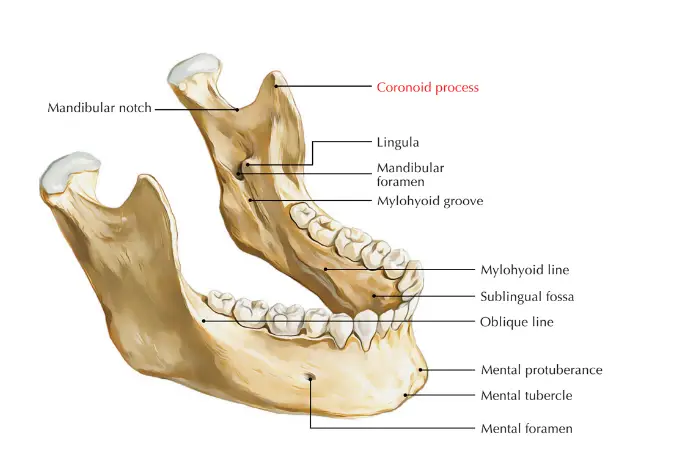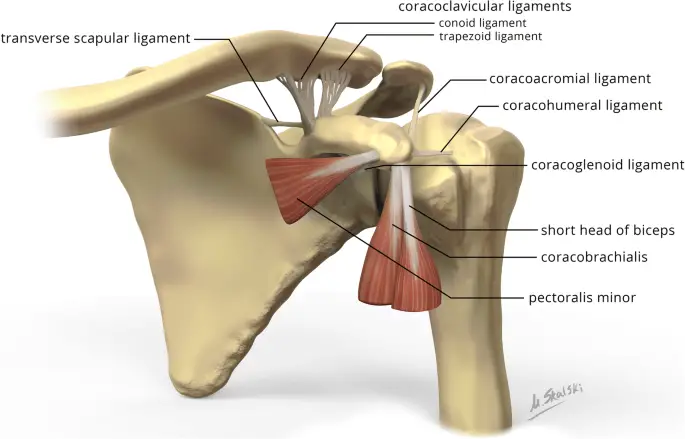The human skeleton is a marvel of evolutionary design, comprising numerous bones that vary greatly in shape, size, and function. Among these, the coronoid and coracoid processes represent two lesser-known yet crucial anatomical structures, each playing a distinct role in the body’s mechanics. While they may sound similar, their functions, locations, and implications in health are uniquely different.
The coronoid process is a triangular eminence projecting from the ulna, one of the two bones in the forearm, and it plays a pivotal role in elbow joint stability and movement. In contrast, the coracoid process is a hook-like structure projecting from the scapula, or shoulder blade, serving as an attachment point for muscles and ligaments and aiding in shoulder stability and motion. These processes are critical in facilitating effective movement and maintaining stability in their respective locations.
Despite their functional importance, both the coronoid and coracoid processes are prone to specific injuries and disorders, which can significantly impact mobility and quality of life. Understanding the anatomy, potential injuries, and treatment options for these structures can aid in better diagnosis and management of related conditions.

Anatomy of Coronoid
Location in the Body
The coronoid process is a key anatomical feature of the ulna, one of the two long bones in the forearm. Positioned on the anterior (front) part of the ulna, near the elbow, it plays a crucial role in the elbow’s structure. Its location allows it to interlock with the humerus (upper arm bone) when the arm bends at the elbow, thus facilitating effective joint movement.
Structural Characteristics
The coronoid process features a triangular shape that extends from the ulna. This prominence serves as an anchor point for important ligaments and tendons in the elbow. It is characterized by its rough surface, which provides additional grip for these soft tissues. The base of this process is broad and narrows down to a pointed tip, which fits into the trochlea of the humerus during elbow flexion.
Functional Role
The primary function of the coronoid process is to provide stability to the elbow joint by fitting snugly into the trochlear notch of the humerus. This interlocking mechanism prevents hyperextension of the elbow and helps maintain the joint’s alignment during various motions. Additionally, it serves as an attachment site for the brachialis muscle, one of the major muscles involved in elbow flexion. This muscle’s contraction pulls on the coronoid process, thereby bending the elbow.
Anatomy of Coracoid
Location and Description
The coracoid process is a small, hook-like structure protruding from the scapula, or shoulder blade, near the shoulder joint. It is situated on the superior, anterior portion of the scapula, just below the collarbone (clavicle). This strategic positioning makes it an essential part of the shoulder mechanism.
Structural Details
The coracoid process is notable for its curved shape and sturdy build, which provide a robust attachment site for several ligaments and muscles. These include the coracoacromial ligament, pectoralis minor, and the short head of the biceps brachii. Its surface is roughened for the attachment of these soft tissues, which utilize the coracoid process as a lever for movement.
Functionality in Movement
In the dynamic environment of the shoulder, the coracoid process plays a fundamental role in facilitating motion and providing mechanical leverage. By serving as an attachment point for muscles and ligaments, it aids in the lifting of the arm, stabilizes the shoulder, and helps prevent dislocation. Its influence on shoulder mechanics is pivotal, particularly during overhead activities and lifting motions.
Comparative Analysis
Structural Differences
While both the coronoid and coracoid processes serve as critical attachment sites for muscles and ligaments, their structural differences are distinct. The coronoid process is triangular and located in the forearm, primarily involved with the elbow joint. In contrast, the coracoid process is hook-like and associated with the shoulder blade, influencing the shoulder joint’s functionality. These differences in shape and location underscore their specialized roles in the skeletal system.
Functional Contrasts
Functionally, the coronoid and coracoid processes contribute to their respective joints in different ways. The coronoid process prevents the elbow from hyperextending and aids in flexion, whereas the coracoid process provides leverage and stability to the shoulder, facilitating a range of movements from rotation to lifting. Each process thus enhances the stability and flexibility of its joint, tailored to the specific demands of their positions.
Evolutionary Perspectives
From an evolutionary standpoint, the development of the coronoid and coracoid processes reflects the adaptations to various physical demands. The coronoid process has evolved to support complex elbow movements necessary for tasks ranging from throwing to lifting, while the coracoid process has adapted to the need for increased shoulder stability and mobility, essential for everything from climbing to tool use. These adaptations highlight the evolutionary ingenuity of the musculoskeletal system, ensuring survival and functional efficiency across diverse activities.
Medical Significance
Common Injuries
The coronoid process and coracoid process are prone to specific injuries that can severely affect mobility and quality of life. Injuries to the coronoid process often occur due to direct trauma or falls that force the elbow beyond its normal range of motion, leading to fractures. Coracoid process injuries typically result from overuse or acute trauma, resulting in fractures or muscle and ligament tears.
- Coronoid fractures are generally linked with dislocations of the elbow and can lead to joint instability.
- Coracoid fractures often occur with other shoulder injuries such as shoulder dislocations.
Diagnostic Approaches
Diagnosing injuries to the coronoid and coracoid processes requires a combination of clinical examination and imaging techniques. Clinicians will first perform a physical examination, checking for pain points, swelling, and range of motion. Imaging tests include:
- X-rays to visualize bone structures and alignments.
- CT scans for a more detailed view of the bone and surrounding soft tissues.
- MRI scans to assess any damage to ligaments and cartilage.
Treatment Options
Treatment strategies for injuries to the coronoid and coracoid processes depend on the severity of the injury.
- Mild injuries may only require rest, ice application, compression, and elevation (RICE).
- Severe cases, such as fractures or significant ligament damage, may require surgical intervention. Surgical techniques may include:
- Open reduction and internal fixation (ORIF) to realign and stabilize broken bones.
- Ligament repair to reattach torn ligaments.
Research and Advances
Recent Studies
Recent research into the treatment of coronoid and coracoid process injuries has focused on improving surgical outcomes and rehabilitation protocols. Studies have examined the biomechanics of these areas to better understand how injuries affect joint stability and function.
- Current research on the coronoid process examines the impacts of different fracture types on elbow stability and the effectiveness of various surgical techniques in restoring function.
- Innovative studies on the coracoid process have explored the long-term outcomes of surgical repair and the role of physical therapy in speeding recovery and preventing future injuries.
Technological Advancements
Technological advancements have significantly enhanced the diagnosis, treatment, and rehabilitation of injuries related to the coronoid and coracoid processes.
- Improved imaging technologies, such as 3D CT scans and high-definition MRIs, offer unprecedented views of the internal structures of the elbow and shoulder, aiding in more accurate diagnoses.
- Surgical innovations include the development of minimally invasive techniques and better fixation devices, which reduce recovery time and improve functional outcomes.
- Rehabilitation technology has also advanced, with the introduction of robotic-assisted therapy and virtual reality systems that help patients regain strength and mobility more effectively.
Frequently Asked Questions
What is the Coronoid Process?
The coronoid process is a prominent projection on the anterior proximal ulna, playing a crucial role in elbow joint stability by fitting into the elbow’s trochlear notch.
What is the Coracoid Process?
The coracoid process is a small hook-like structure that projects from the upper front part of the scapula. It serves as an attachment site for several muscles and ligaments of the shoulder.
How do Coronoid and Coracoid Injuries Occur?
Injuries to the coronoid and coracoid processes typically result from traumatic events such as falls, sports injuries, or direct impacts. These can lead to fractures, dislocations, or muscular and ligament tears.
What are the Symptoms of Coronoid Process Injury?
Symptoms of a coronoid process injury include pain at the elbow, swelling, bruising, and a decreased range of motion. In severe cases, elbow instability may also occur.
How is Coracoid Process Injury Treated?
Treatment for coracoid process injuries may involve rest, ice, compression, and elevation (RICE), physical therapy, or surgery, depending on the severity of the injury and the specific structures involved.
Conclusion
The distinctions between the coronoid and coracoid processes illustrate the complexity and specialization within human anatomy. Their roles are indispensable for the stability and function of the elbow and shoulder joints, respectively. Awareness and knowledge of these processes are essential for diagnosing and treating related injuries effectively.
Understanding these anatomical structures can significantly enhance approaches to treatment and rehabilitation, potentially improving outcomes for patients experiencing related injuries. Advances in medical science continue to shed light on these critical areas, promising better management and recovery strategies in orthopedics.

